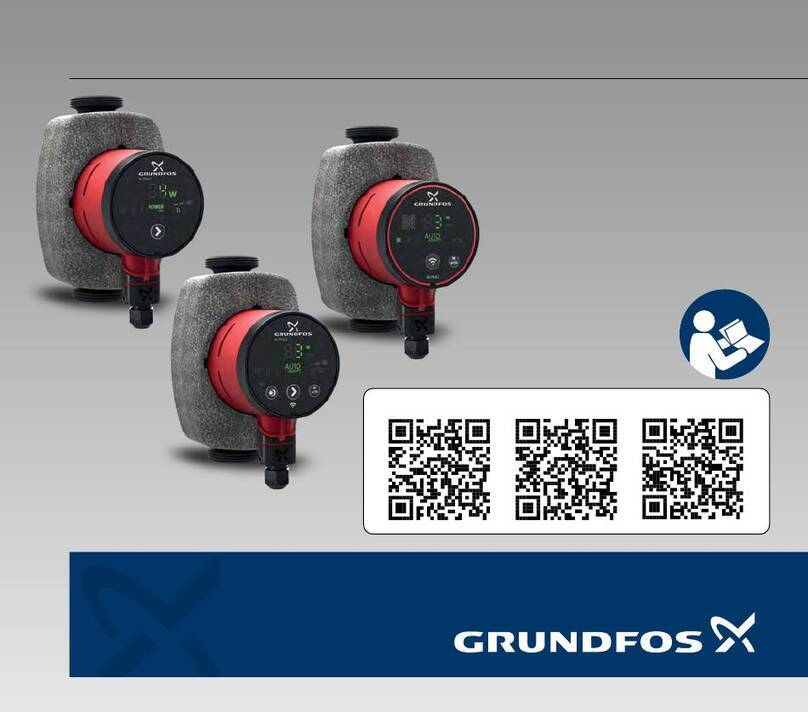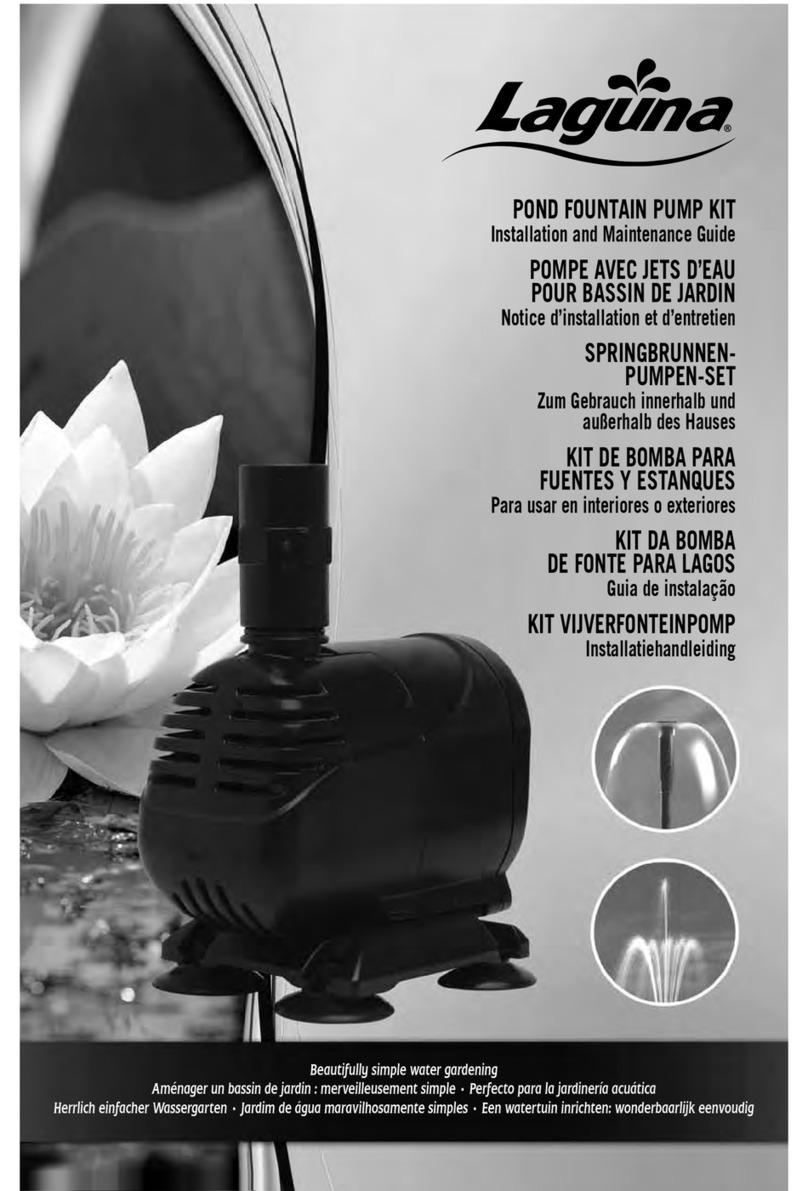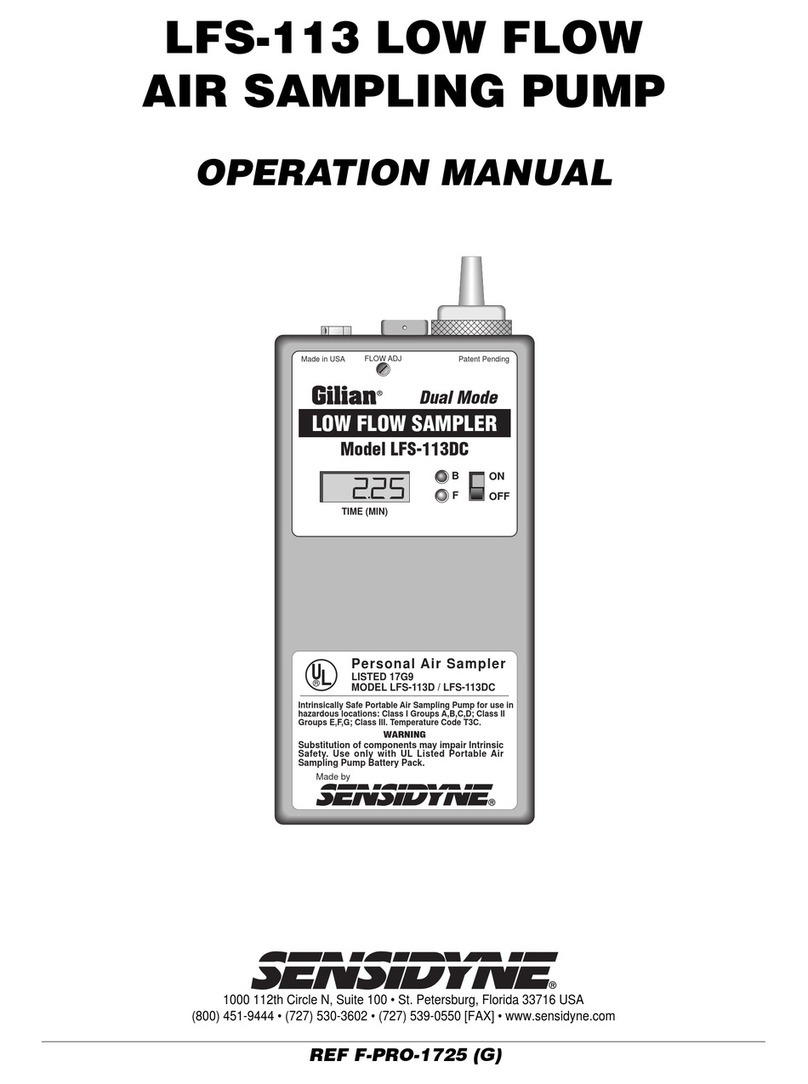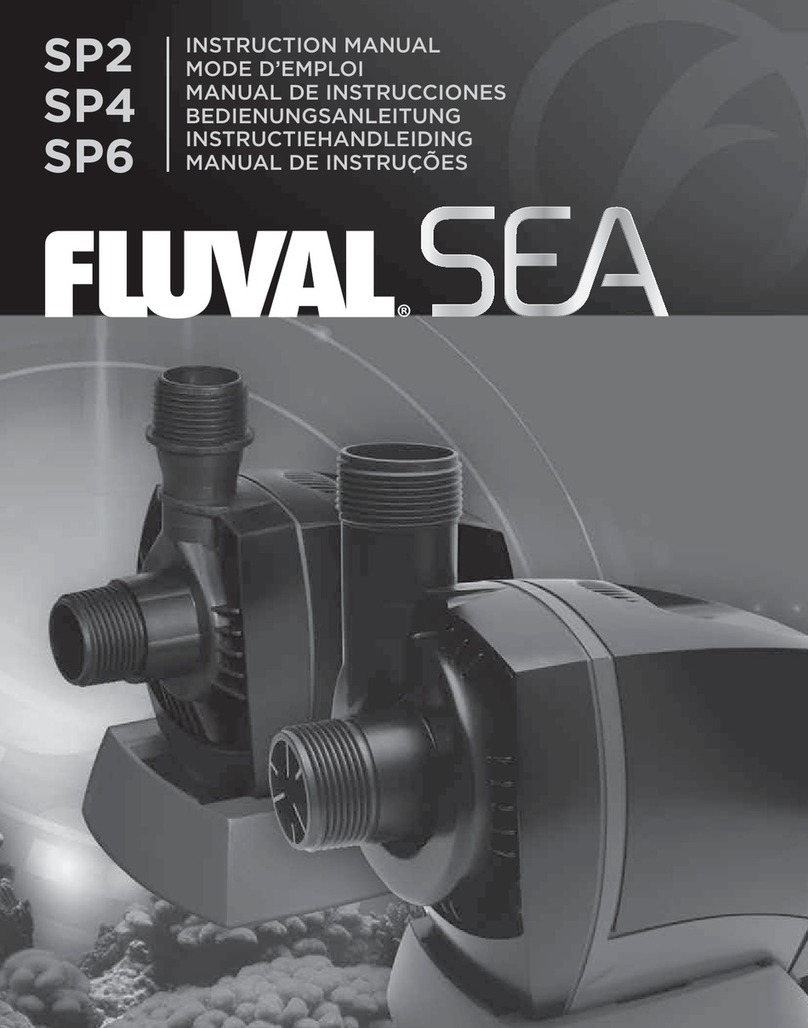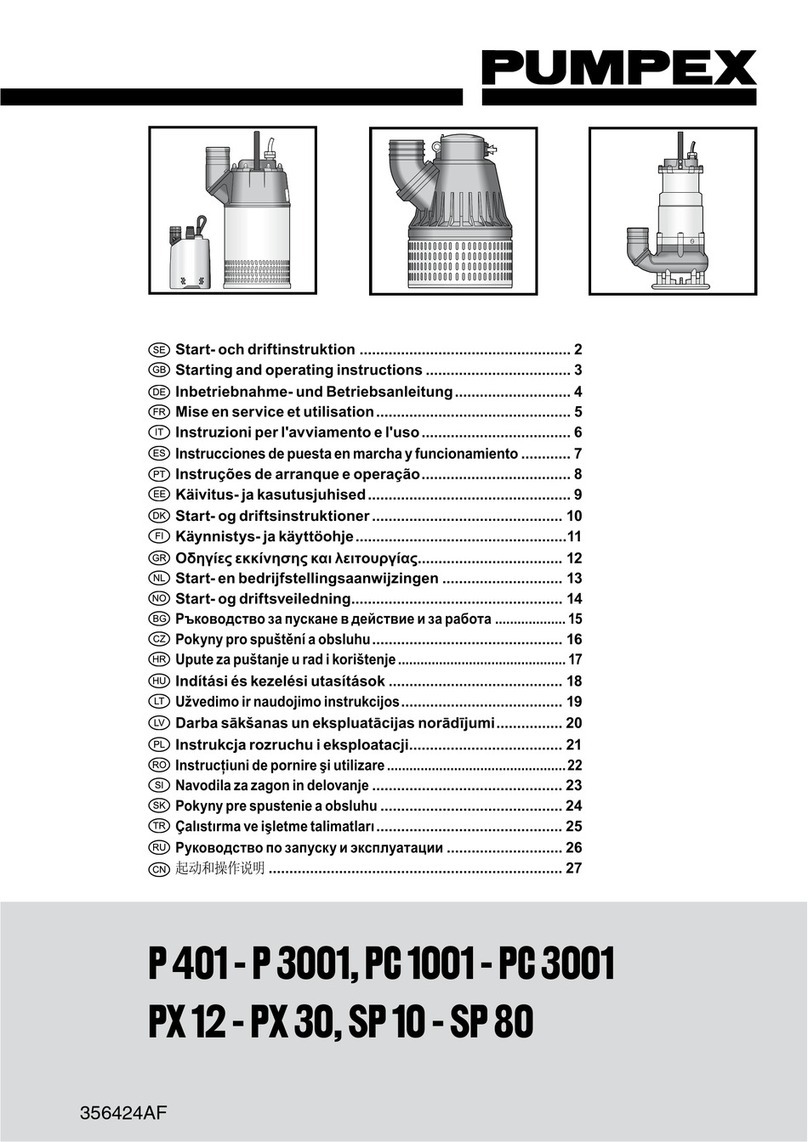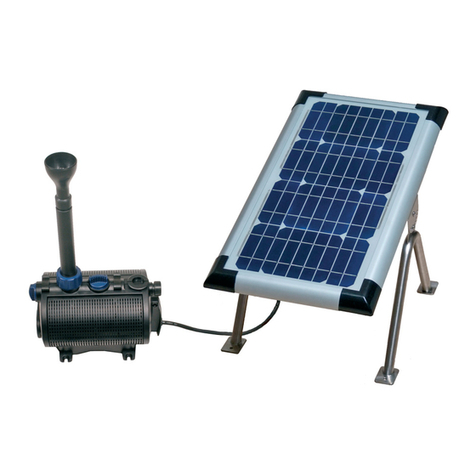Geotech PFAS Free Series User manual

Rev 4/15/2020 Part # 11150324
PFAS Free Portable
Bladder Pump
Installation and Operation Manual


1
Table of Contents
Section 1: System Description........................................................................... 4
Function and Theory ......................................................................................... 4
System Components......................................................................................... 5
Bladder Assembly ............................................................................................. 5
Pump Housing................................................................................................... 5
Intake screen..................................................................................................... 5
Optional Drop Tube Intake Assembly ............................................................... 5
Section 2: System Installation............................................................................ 6
Safety Cable...................................................................................................... 6
Pump Controller ................................................................................................ 6
Pump Tubing Lines ........................................................................................... 6
Reverse Coil Method......................................................................................... 7
Optional Drop Tube Intake Assembly ............................................................... 7
Section 3: System Operation.............................................................................. 8
Flowrates........................................................................................................... 8
Example Flow Rates ......................................................................................... 9
Selecting an Air Source...................................................................................10
Volume of Tubing ............................................................................................10
Air Volume of Bladder Pumps.........................................................................10
Determining PSI ..............................................................................................12
Section 4: System Maintenance....................................................................... 13
Replacement Parts.......................................................................................... 20
Section 5: System Troubleshooting ................................................................ 21
Section 6: System Specifications .................................................................... 22
Section 7: Replacement Parts List.................................................................. 24
1.66 Bladder Pump Components.................................................................... 24
.850 Bladder Pump Components.................................................................... 26
.675 Bladder Pump Components.................................................................... 28
EC Declaration of Conformity .......................................................................... 32
The Warranty...................................................................................................... 33

2
NOTE
DOCUMENTATION CONVENTIONS
This document uses the following conventions to present information:
An exclamation point icon indicates a WARNING of a situation
or condition that could lead to personal injury or death. You
should not proceed until you read and thoroughly understand the
WARNING message.
WARNING
CAUTION
A raised hand icon indicates CAUTION information that relates to
a situation or condition that could lead to equipment malfunction
or damage. You should not proceed until you read and thoroughly
understand the CAUTION message.
A note icon indicates NOTE information. Notes provide additional
or supplementary information about an activity or concept.

3
For long-term storage greater than one week, care should be taken to clean and dry all
pump components. This will help with long-term reliability. Deionized water or a silicone-
based lubricant can be used on the O-ring seals to promote longevity and elasticity.
Pump operation and decontamination should be performed to standard operating
procedures.
Operation of system utilizing non-Geotech manufactured equipment could result in
equipment failure or malfunction and may void the warranty. This includes air and fluid
tubing.
Avoid operating the system without securely anchoring safety cable attached to down well
components.
Always wear nitrile powderless gloves and be mindful of contaminated fluids contacting
your person and entering the environment when operating any ground water sampling
device.
WARNING
The following applies only to users in European countries:
This product is designated for separate collection at an appropriate collection
point. Do not dispose of as household waste.
For more information, contact the seller or the local authorities in charge of waste
management.
Do not operate this equipment if it has visible signs of significant
physical damage other than normal wear and tear.
Notice for consumers in Europe:
This symbol indicates that this product is to be collected
separately.
In order to ensure that your pump has a long service life and
operates properly, adhere to the cautions below and read
this manual before use.

4
Section 1: System Description
Function and Theory
The PFAS Free Portable Bladder Pump is designed specifically for sampling per- and
polyfluoroalkyl substances (PFAS) such as perfluorooctanoic acid (PFOA) and
perfluorooctane sulfonate (PFOS) in groundwater. PFAS compounds are synthetic
chemicals used in firefighting foams, stain resistant carpets, and other repellant/non-stick
applications. A chemically stable substance with low volatility, PFAS compounds are not
absorbed well in soil and can migrate to water sources. The PFAS Free Portable Bladder
pump is made with PFAS free materials such as 316 Stainless Steel, high-density
polyethylene (HDPE), and Buna-Nitrile to provide representative water samples for
testing.
The PFAS Free Portable Bladder Pump is proven to not contribute any PFAS substances
to samples. Complete pump, tubing and safety cable have been soak tested and
laboratory analyzed under ‘EPA 537 Modified’ method. The samples from those tests
showed non-detect for all 25 PFAS analytes. (See Section 6: System Specifications)
The pump is ideal for both gentle low-flow sampling and higher flow rate purging. Timed
ON/OFF cycles of compressed air alternately squeeze the flexible bladder to displace
water out of the pump to the surface and then exhaust the air allowing the pump to refill.
Fluid enters the pump through the fluid inlet check valve at the bottom of the pump body
via hydrostatic pressure. The bladder then fills with fluid. Compressed air enters the space
between the bladder and the interior of the pump housing. The intake check valve
(bottom) closes and the discharge check valve (top) opens. Compressed air squeezes the
bladder, pushing the fluid to the surface (see Figure 1-1). The discharge check valve
prevents back flow from the discharge tubing. Operated by the Bladder Pump Controller
(BP Controller) or Geocontrol PRO, this cycle automatically repeats.
Compressed air does not contact the sample. The bladder prevents contact between the
pump drive air and the fluid sample.
Figure 1-1: Bladder Pump Operation

5
Figure 1-1: Bladder Pump Operation
System Components
A Geotech Portable Bladder Pump consists of four components:
- Bladder Assembly
- Pump Housing
- Internal Tube Assembly
- Intake Screen Assembly
* Optional: Drop Tube Intake Assembly. See Section 7: Replacement Parts List.
Bladder Assembly
The bladders are made from extruded Polyethylene (PE) to provide a long life and to
ensure undisturbed samples in PFAS sampling applications. The internal bladders are
easily replaceable, see Section 4: System Maintenance.
Pump Housing
The bladder pump housing is constructed of electro polished 316 Stainless Steel. The
black Buna Nitrile O-rings provide the high-pressure seals between the end caps and the
housing tube.
Intake screen
The intake filter screen is constructed of 316 Stainless Steel and is easily removable for
field maintenance. The intake filter screen protects and extends the life of the bladder
material (see Warranty).
Optional Drop Tube Intake Assembly
An optional drop tube can be used to sample from depths below the specified maximum
sampling depth. The Drop Tube Assembly connects a remote intake to the pump through
a tube connected to the pump inlet. The intake depth can be any custom length of tubing.
The pump assembly itself must be submerged below the water level. This means the
depth to water cannot exceed the maximum pumping depth of the pump.
Read and understand the portable generator and/or portable air
compressor user manual for proper installation and operation, and
Earth grounding instructions. If using portable compressed gas tanks,
exercise proper caution, use safety protection devices as outlined by
the supplier, and observe any additional safety requirements
mandated by local jurisdiction.
If using a drop tube assembly not provided by Geotech, ensure all
materials are PFAS testing approved. Use of unapproved materials
may contaminate samples.

6
Section 2: System Installation
The user must determine site-specific parameters such as water level, recharge rate, and
adherence to low flow purging guidelines.
Safety Cable
Before deploying any sampling pump, secure a safety cable from an anchoring point at or
near the wellhead to the top of the pump. When testing in PFAS contaminated
environments, ensure the safety cable does not have any nonstick or repellant coating as
these coatings may be made with PFAS materials and will contaminate testing samples.
Ensure all safety cables are PFAS testing approved before use.
Pump Controller
Geotech PFAS Free Portable Bladder Pumps can be operated with Geotech’s Geocontrol
PRO, BP Controller 300 PSI, or BP Controller 500PSI. Be sure to consult the user guide
of the controller you are using.
The Geocontrol PRO is an easy-to-use portable compressor and logic unit specifically
designed to operate Geotech’s PFAS Free Portable Bladder Pumps.
Pump Tubing Lines
The Geotech PFAS Free Portable Bladder Pump requires two tubing lines. One of the
lines is used for the air supply and exhaust. The second line is used for discharge fluid.
See Section 6: System Specifications for tubing sizes.
Failure to attach air and fluid lines to the appropriate ports could
result in damage to the bladder.
In the case that a PFAS Free Portable Bladder Pump is deployed deeper
than 155’ (47 m) with a Geocontrol PRO, the pump’s overall flow rate will
decrease. To obtain full bladder volumes in this scenario, use the
Bladder Pump Controller 300PSI.
Read the following before installation to prevent damage to the
bladder pump.
Use of an air source and controller not supplied by Geotech could
result in pressure buildup and unexpected pressure storage in the
pump and airline. Operation of the pump is not recommended with
equipment other than that provided by Geotech.

7
Reverse Coil Method
When lowering the pump into the well, it is important to reverse the natural bend of the
coiled tubing so that the tubing will straighten out as it is lowered (see figure 2-1). As the
pump and tubing are lowered into the well, the direction of the bend should be reversed
from the direction in which it is coiled. If the tubing is allowed to uncoil naturally and the
natural bend not interrupted, the tubing will continue its coil into the well. Using the reverse
coil method will avoid difficulty in lowering the pump into the well, especially when the well
is not vertical, or has come out of alignment for any reason.
Optional Drop Tube Intake Assembly
If a Drop Tube Intake Assembly is employed, a third tubing line is necessary to connect
from the bottom of the bladder pump to the top of the drop tube intake.
For deployment of optional Drop Tube Intake Assembly, attach desired length of drop tube
between the intake’s hose barb and hose barb on bottom of pump. For added security, a
safety cable may be installed to support the drop tube intake to the bottom of pump.
Send the drop tube intake down the well followed by the drop tube tubing, then the pump,
and finally the air and fluid discharge lines.
Figure 2-1: Reverse Coil Method

8
Section 3: System Operation
Once tubing and safety cable are connected, slowly deploy the pump into the well. If depth
to water is known, a mark can be placed on the tubing to indicate when the pump has
reached the desired level.
The pump must be fully submerged. Optimal pump performance is achieved with
submergence of greater than 10’ (3m) of water column. Less submergence could result in
reduced pump performance and physical damage to the bladder. Worn bladders can
develop a shape memory and may not be able to fill completely without sufficient
submergence. Pumping will still be achieved and the sampling event can be completed.
Once the pump is at the desired level within the well, set the controller DISCHARGE and
FILL timers. These settings should be such that the bladder is never over compressed.
Set the pressure cycle so the fluid stream exiting the fluid line starts to fall off when the
DISCHARGE timer expires. If the controller being used has a pressure gauge, you will
notice the pressure level will climb and then stabilize during pumping and start to increase
after all of the water has been evacuated from the pump. If you notice the pressure
increasing after a pump cycle, reduce the pressurization/discharge time.
Using the Example Flow Rates, set the FILL TIME to optimize the amount of fluid
discharged during the pressure cycle.
Both FILL TIME and DISCHARGE TIME vary depending on submergence, depth to water,
tubing size, and overall tubing length.
More information can be found in the user manual specific to the controller you are using.
Flowrates
Bladder Pump flow rates are influenced by pump size (diameter and length), pump depth
and submergance, as well as controller selection (i.e. compressor performance, valve flow
coefficient). A large pump at shallow depths will produce the most flow, and a small pump
at maximum depths will produce the least amount of flow.
Factors that increase flow:
increased submergance (depth of pump below water line).
a strong compressor, like the Geocontrol PRO, will enable fast pressure build up
in the airline tubing and pump cavity.
a clean intake screen will maximize the amount of water entering into the pump.

9
Example Flow Rates
Table 3-1: Flow Rates with 25’ (7.6m) Airline
@ 25 ft. (7.6 m) airline*
(3 ft. (0.9 m) submergence)
Pump Size:
Discharge Tube
Size:
Flow:
Approx. Geocontrol PRO Settings
Fill Time:
Discharge Time:
1.66 x 36"
(4 x 91 cm)
1/4" ID x 3/8" OD
(64 x 127 mm)
43 oz/min
(1.3 L/min)
10 sec.
7 sec.
1.66 x 18"
(4 x 46 cm)
33 oz/min
(1 L/min)
5 sec.
5 sec.
0.85 x 18"
(2.2 x 46 cm)
.17" ID x 1/4" OD
(43 x 64 mm)
20 oz/min
(0.6 L/min)
1 sec.
2 sec.
0.675 x 18"
(1.7 x 46 cm)
10 oz/min
(0.3 L/min)
1 sec.
2 sec.
Table 3-2: Flow Rates with 150’ (46m) Airline
@ 150 ft. (46 m) airline*
(3 ft. (0.9 m) submergence)
Pump Size:
Discharge Tube
Size:
Flow:
Approx. Geocontrol PRO Settings
Fill Time:
Discharge Time:
1.66 x 36"
(4 x 91 cm)
1/4" ID x 3/8" OD
(64 x 127 mm)
9 oz/min
(260
mL/min)
20 sec.
55 sec.
1.66 x 18"
(4 x 46 cm)
6 oz/min
(175
mL/min)
15 sec.
40 sec.
0.85 x 18"
(2.2 x 46 cm)
.17" ID x 1/4" OD
(43 x 64 mm)
2 oz/min
(59
mL/min)
8 sec.
30 sec.
0.675 x 18"
(1.7 x 46 cm)
1 oz/min
(27
mL/min)
5 sec.
25 sec.
* Airline tubing size: .17”ID x ¼” OD (4 x 6 mm)
Speak with a Geotech representative to determine the best configuration to fulfill your
sampling needs.
Flow rates are based on 3’ (0.9 m) of pump submergence. Field
environments typically provide over 10’ (3 m) of submergence, which
increases flow.

10
Selecting an Air Source
The Geocontrol PRO is an easy-to-use portable compressor and logic unit specifically
designed to operate Portable Bladder Pumps deployed down to 180’ (55 m) or less.
Air consumption depends on the volume of tubing and the size of deployed Bladder Pump.
Follow the general guidelines and examples below to calculate the air consumption for
specific sampling configurations.
Volume of Tubing
TUBING LENGTH
TUBE I.D.
1 ft./
0.3 m
10 ft./
3 m
50 ft./
15 m
100 ft./
30 m
250 ft./
76 m
500 ft./
152 m
0.17 in/
0.43 cm
0.3 in³/
5 cm³
3 in³/
50 cm³
15 in³/
246 cm³
30 in³/
492 cm³
75 in³/
1230 cm³
150 in³/
2460 cm³
0.25 in/
0.64 cm
0.6 in³/
10 cm³
6 in³/
100 cm³
30 in³/
492 cm³
60 in³/
984 cm³
150 in³/
2460 cm³
300 in³/
4920 cm³
Air Volume of Bladder Pumps
BP DIAMETER
BP LENGTH
VOLUME (in³)
1.66 in/
4 cm
36 in/
91 cm
78 in³/
1278 cm³
1.66 in/
4 cm
18 in/
46 cm
39 in³/
640 cm³
0.85 in/
2.2 cm
18 in/
46 cm
10 in³/
164 cm³
0.675 in/
1.7 cm
18 in/
46 cm
6 in³/
100 cm³
Calculation guideline:
Volume of Tubing (in³/cm³)
+ Volume of Bladder Pump (in³/ cm³)
= Air Consumption per cycle (in³/ cm³)
If planning to use an air compressor, use one with a reserve tank to ensure proper air
supply to the pump. If using a Nitrogen Tank, see Figure 3-1 for Nitrogen Tank Volume vs.
Bladder Pump consumption. Ensure the air compressor is constructed from suitable
materials for sampling PFAS compounds.

11
Figure 3-1: Tank Volume vs. BP Consumption

12
Determining PSI
Determine the air pressure needed to operate the Bladder Pump based on the length of
the air supply line to the pump (well depth). Use the simplified formula:
0.5 PSI (per foot) + 10 PSI (to account for tubing friction) = required PSI
0.12 bar (per meter) + 0.7 bar (to account for tubing friction) = required bar
As mentioned above, the additional 10 PSI/ 0.7 bar is to account for the pump itself and
friction loss along the airline tubing. When the length of the airline is 50’ (15 m) or less,
there is no need for the additional pressure.
The formulas stated above are not absolute, and are meant to
provide baseline information.

13
Section 4: System Maintenance
Remove the pump from the well. It is not necessary to remove the air and sample lines
from the pump. Upon removal, note the pump may be filled with fluid.
Remove the pump from the well. It is not necessary to remove the air and sample lines
from the pump. Upon removal, the pump may be filled with fluid.
Bladder Removal Steps (all models)
1. Remove the bottom intake assembly and outer housing by turning the housing
counter-clockwise.
Use your hand or a strap wrench
If the pump does not easily come off, use the wrench flats on the cap to
provide leverage. The housing should twist/slide off (1.66 models).
DO NOT grip the hose barbs.
For .85 and .675 models, use a wrench that is one size bigger than the
bolts on the hose barbs. (EX: use a 7/16 wrench on a .850 model)
oDO NOT grip the hose barbs.
oUsing a larger wrench will prevent the hose barbs from being
removed. The tool should only be used for leverage to loosen
the part.
If the bottom intake is difficult to remove, remove the snap ring, disc,
and screen and then use a wrench for removal.
Figure 4-1: Removal of the bottom intake and outer housing
Geotech uses black Buna-N O-rings for the PFAS free portable bladder
pumps. If you receive an O-ring from Geotech that is not black, do not
use the O-ring on the bladder pump and contact a Geotech
representative. Using incorrect materials while testing for PFAS
compounds will contaminate testing samples.

14
2. Remove the lower Compression Ring by pulling it off the end of the internal
center tube assembly.
Figure 4-2: Removal of bottom Compression Ring
3. Remove the upper Compression Ring by sliding it over the bladder and over the
end of the internal center tube assembly.
Figure 4-3: Removal of upper Compression Ring
4. Pulling from the lower end of the bladder, slide the bladder off the internal center
tube weldment assembly.
Figure 4-4: Removal of Bladder

15
5. Remove all O-rings.
If needed, use a flat object to help the O-ring out of the groove on the center
tube weldment assembly,
Do not over-stretch, damage, or puncture the O-rings in any way.
Figure 4-5: Removal of O-rings
6. Clean and prepare replacement parts as needed.
1.66 Bottom Intake Disassembly
1. Pull the Check Ball Retainer from the Bottom Intake Assembly.
Figure 4-7a: Check Ball
Retainer
Figure 4-7b: Removing Check
Ball Retainer
Figure 4-7c: Check Ball
Retainer Removed
2. Remove the SS Check Ball from the inside of the Bottom Intake Assembly.
3. Remove all O-rings on the assembly.
If needed, use a flat object to help the O-rings out of the grooves on the
Bottom Intake Assembly
Do not over-stretch, damage, or puncture the O-rings in any way.
4. Clean and prepare replacement parts as needed.
1.66 Bottom Intake Reassembly
1. Install O-ring (#17500119) in the groove on the Check Ball Retainer.
Ensure that O-rings are not twisted.

16
Figure 4-8: Check Ball Retainer O-ring
2. Install O-rings (#11150332 & #1110318) in the grooves on the Bottom Intake
Assembly.
Ensure that O-rings are not twisted.
Figure 4-9: O-rings on the Bottom Intake Assembly
3. Insert the SS Check ball into the Bottom Intake Assembly.
4. Push the Check Ball Retainer in ensuring the O-ring is no longer visible.
SS CheckBall must be inside the Bottom Intake
Assembly.
The configuration shown may damage pump.

17
Bladder Reassembly (all models)
1. Install O-ring on the cap of the center tube weldment assembly.
Figure 4-10: Cap O-ring
2. Install O-ring on the upper end of the center tube weldment assembly.
Figure 4-11: Upper end O-ring
3. Install O-ring on the lower end of the center tube weldment assembly.
Figure 4-12: Lower O-ring

18
4. Slide bladder onto the internal center tube weldment assembly, over the O-ring
on the bottom end of the center tube assembly, and then over the O-ring on the
upper end of the center tube weldment assembly.
Do not to roll the O-rings.
If needed, use Deionized water or a silicone based lubricant on the O-ring
seals to help the bladder slide over the O-rings.
Figure 4-13a: Sliding bladder on
Figure 4-13b: Bladder entirely on
5. Slide the Compression Ring over the bladder to the upper end of the center tube
weldment assembly.
Figure 4-14a: Compression Ring on Bladder
Figure 4-14b: Compression ring secured
This manual suits for next models
4
Table of contents
Other Geotech Water Pump manuals
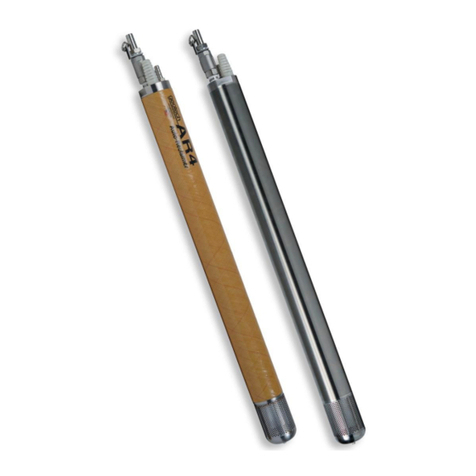
Geotech
Geotech AR4 Series User manual
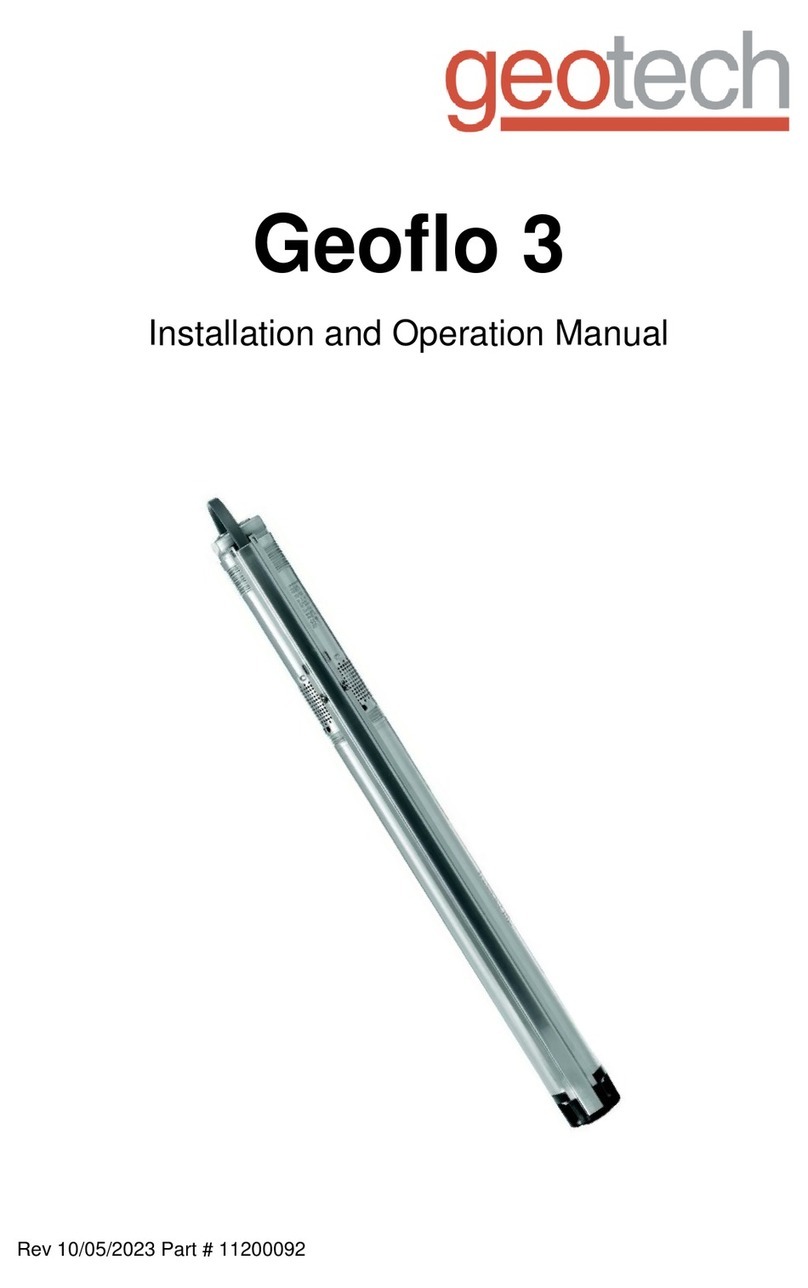
Geotech
Geotech Geoflo 3 User manual
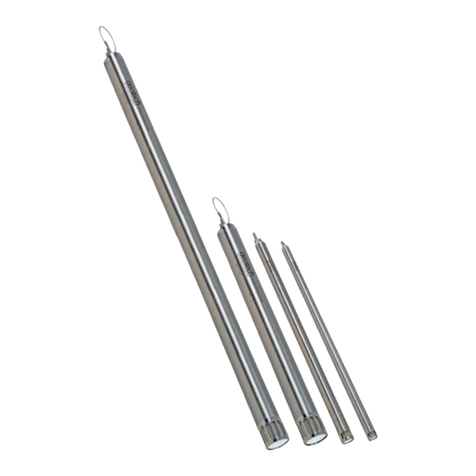
Geotech
Geotech 1.66x36 User manual
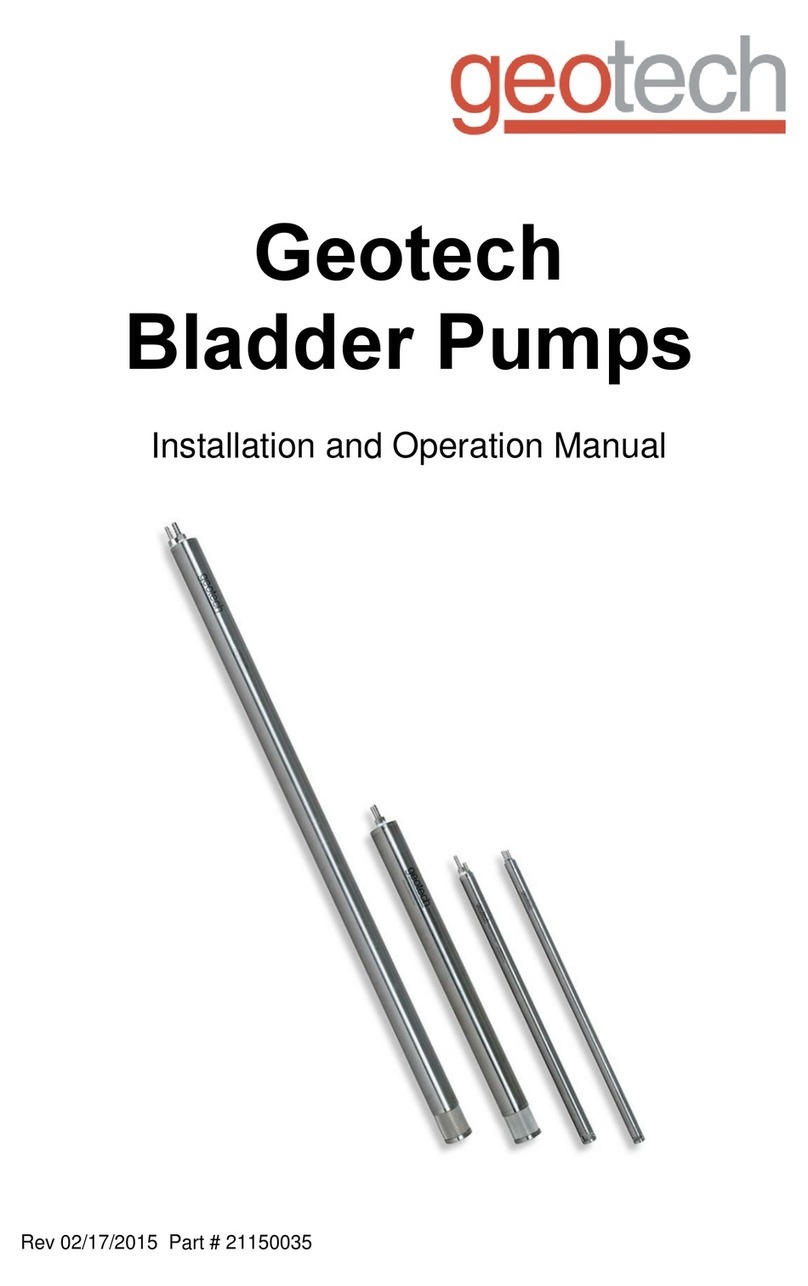
Geotech
Geotech Bladder Pumps User manual
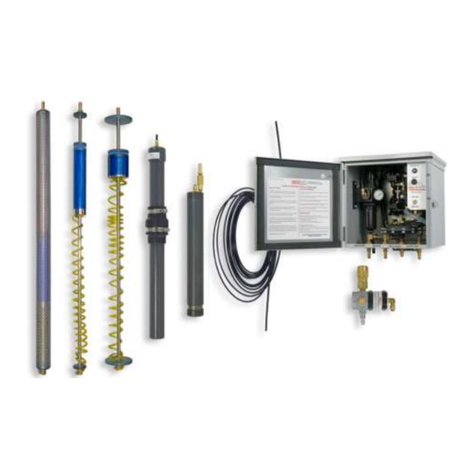
Geotech
Geotech Guzzler User manual
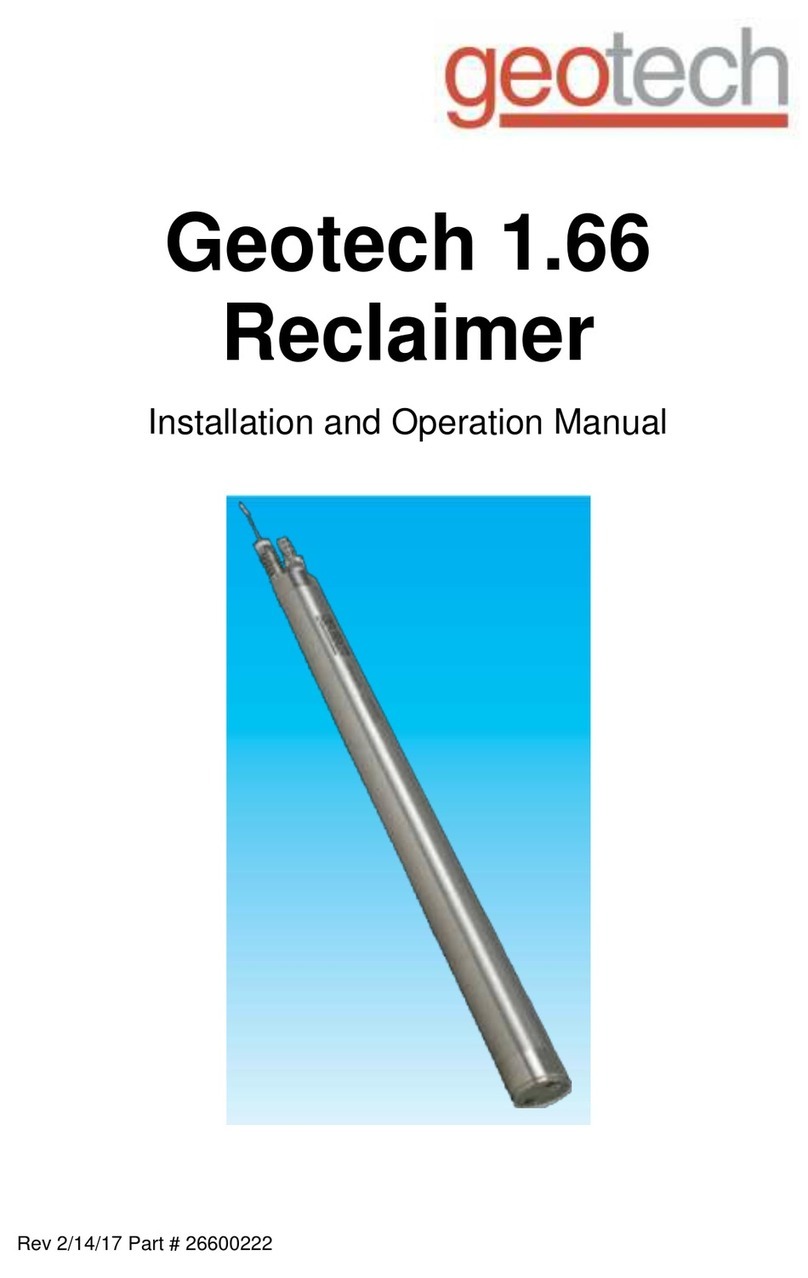
Geotech
Geotech 1.66 Reclaimer User manual

Geotech
Geotech enFUSION Cell 3500 User manual

Geotech
Geotech Geopump I Series User manual
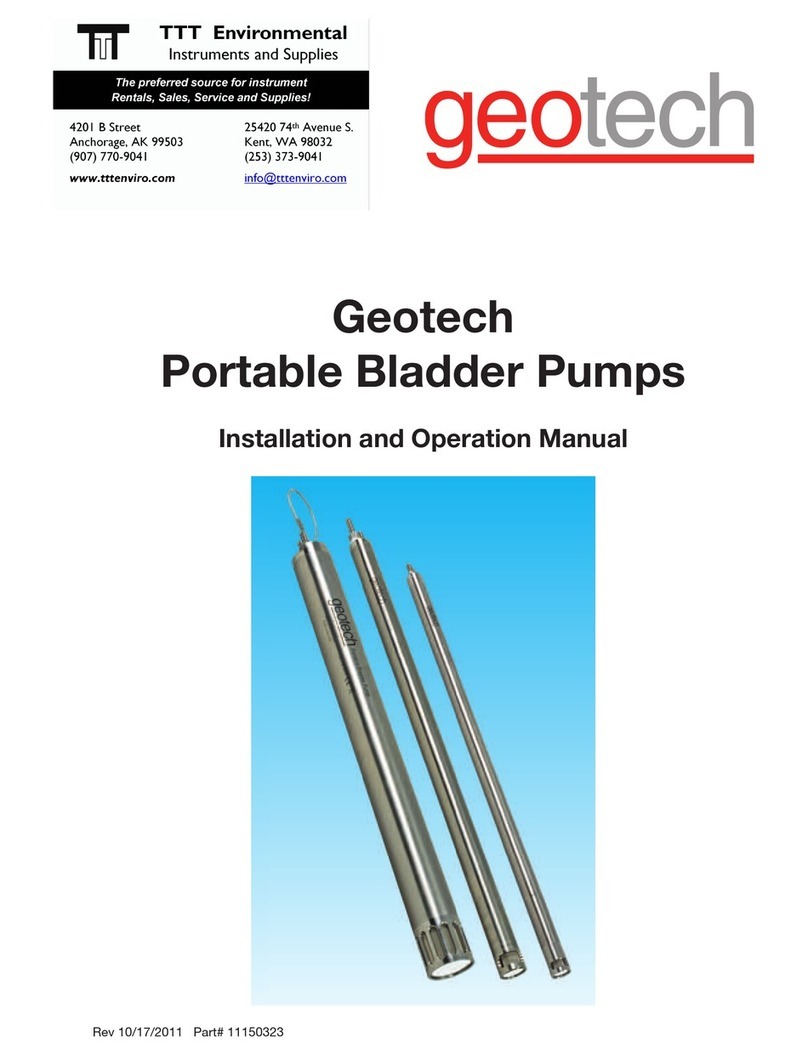
Geotech
Geotech 1.66 Reclaimer User manual
Popular Water Pump manuals by other brands
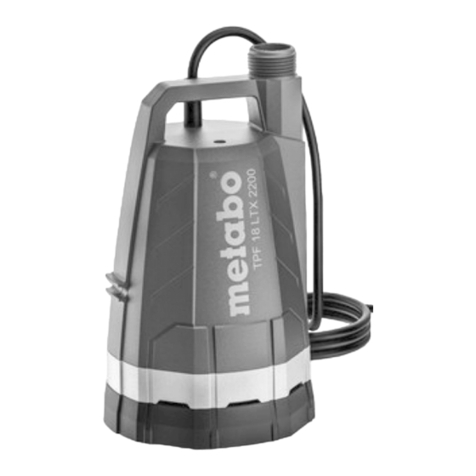
Metabo
Metabo TPF 18 LTX 2200 Original instructions

STM
STM 17350250 user manual

PSG Dover
PSG Dover WILDEN PS20 METAL Engineering, operation & maintenance
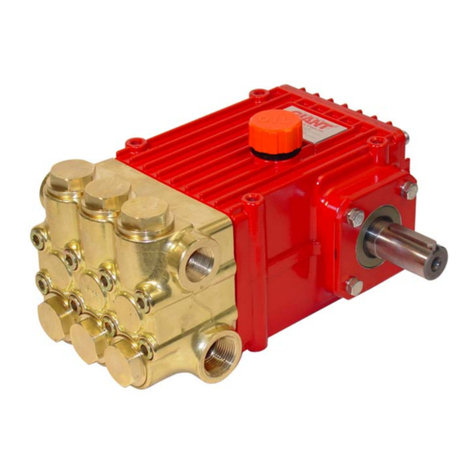
Giant
Giant P435B operating instructions

Pentair Jung Pumpen
Pentair Jung Pumpen PLANCOFIX LINE instruction manual
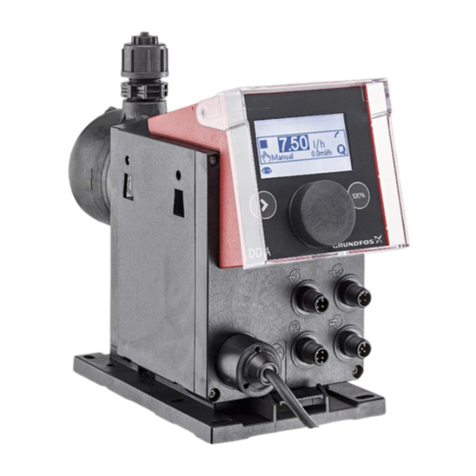
Grundfos
Grundfos SMART Digital S DDA instructions
